Photo


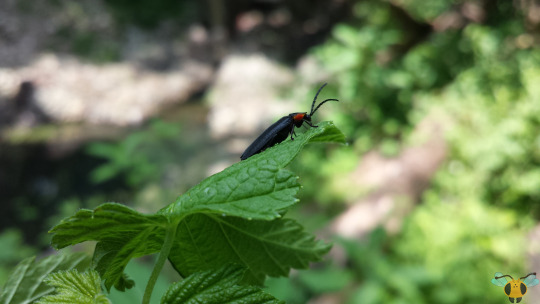


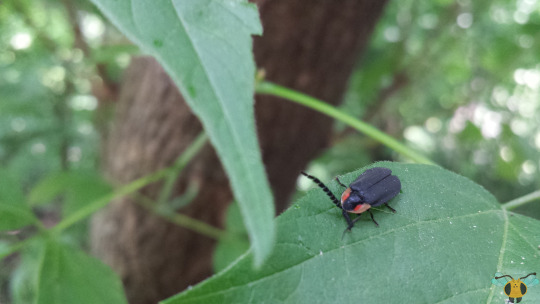

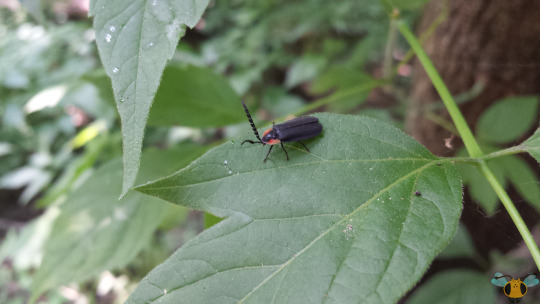
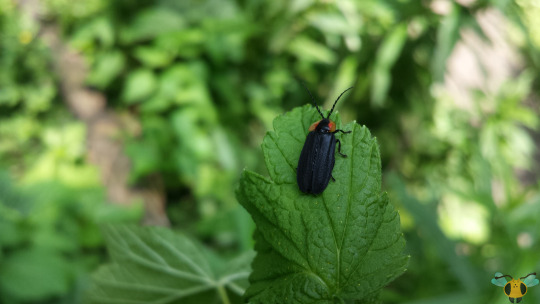
Black Firefly - Lucidota atra
Here we find the rest of the images captured from the daytime flying Fireflies of the managed wilderness. Researching this specie a little more, it’s become apparent that neither males nor females can actively use bioluminescence upon reaching their adult form. Compared to other varieties of Firefly whose entire rear abdominal segments function as light generation, this specie’s light organs are substantially reduced. They are reported to appear as miniscule yellow spots on the abdomen’s last plate (for females) or two plates (for males). With adequate magnification equipment, you’d be hard pressed to discover them. As a shorthand to tell males and females apart, the Black Firefly males tend to have larger, more developed antennae (likely with more prominent serrations too). Think about it in a similar fashion to how some adult Moth males have feathered antennae to increase their detection abilities. This antennae difference may be necessary since without light to signal and communicate to potential mates, males will need to register and follow pheromone cues from females in order to find them.
It’s also fortunate that these Fireflies have good sized eyes (relatively speaking) to aid in their search. Other Fireflies of similar stature may have reduced eyes, which creates a greater reliance on pheromone trails for meeting other Fireflies. Perhaps this variety of Beetle can have the best of both worlds without the need to use light as a communication method. However, it’s not all doom and darkness for this Lampyrid: the larvae are actually bioluminescent! While they resemble smaller, more narrow Trilobite Beetles (at least, in terms of the frontal plates), these young grubs can actually generate light from their rear! Moreover, their bioluminescent flashing can be performed until just after they emerge from their pupa (as demonstrated from reared specimens)! It’s somewhat disappointing that the adults lose their light function, but in this case it may be due to a dramatic change in energy intake and requirements. Larvae don’t need to worry about flight or mating and they eat snails, soft-bodied insects and worms, all protein rich and full of energy! L. atra adults however subsist on pollen and nectar. All their gathered nutrients and stores may have just been to grant the Beetle’s final molt armor, genitals, wings and the wingcase. Do not think less of them, for you can actually actually find them during the day.
Pictures were taken on July 10, 2019 in High Park with a Samsung Galaxy S4.
#jonny’s insect catalogue#ontario insect#beetle#black firefly#firefly#coleoptera#insect#high park#toronto#july2019#2019#entomology#nature#invertebrates
4 notes
·
View notes
Text





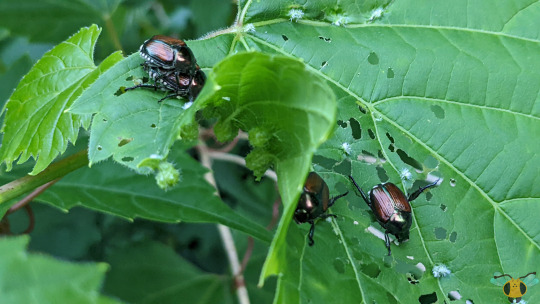
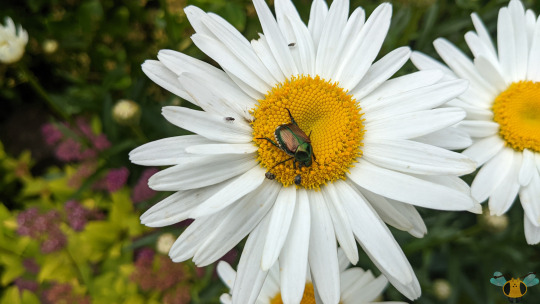
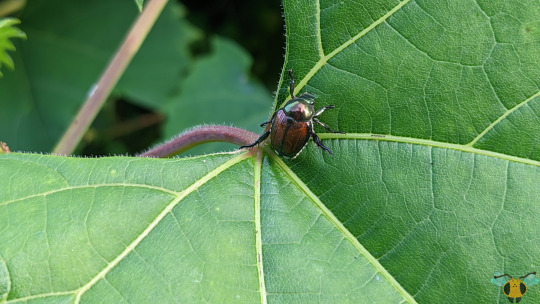


Japanese Beetle - Popillia japonica
After a long absence, these brassy emeralds make a triumphant return to the blog! They've been long overdue, especially since I mentioned in their first post (back in 2019) I would be showing the larger populations that can be found in the neighborhood. Now granted it's not a dramatic increase, but there are many individuals here enjoying the leaves of the suburbs. As can be seen here, these hungry Beetles ignore the leaf's most prominent veins and nibble (somewhat sporadically) on the leaf itself. As generalist feeders, they aren't picky about which plants they land on so long as they are accessible and nutritious. As well, they really love fruits and flowers too! Why, it even seems one individual may even have struck gold with a daisy's pollen...and likely the flower itself if my photo evidence of rose eating remains valid. Given this information, be sure to identify them with certainty if you find them in a flower. The slightly elongated St. John's Wort Beetle is eerily similar at a glance, and yet it's from an entirely different Beetle family.
All the hallmarks of this Scarab Beetle are featured here: leaf skeletonization, iridescent shells and raising their hindlegs to act as a threat display. With regards to the latter, it may not be so readily apparent why the display is a threat. It honestly looks a little silly. However, a vigilant glance at the hindlegs reveals spines just before the midleg. I cannot speak on their strength to pierce or puncture (perhaps a post for a later day) but spines like that are a handy advantage if grabbed from the rear. Speaking of leg observations, looking are the front-most legs can actually allow you to determine if you have a male or female Beetle in your presence. If we use the mating pairs as a reference - since females are mounted by the males - you can actually see that the female Beetles have an elongated, rounded projection jutting out of the end of their tibia! In males, this feature is reduced. Knowing this information, the individual crawling along the daisy is in fact, a female specimen! You can see the tibial projection on her left leg. Do you think the Varied Carpet Beetle next to her noticed?
Pictures were taken on July 1 and 8, 2022 with a Google Pixel 4.
#jonny’s insect catalogue#ontario insect#beetle#japanese beetle#scarab beetle#coleoptera#insect#mating pair#july2022#2022#toronto#nature#entomology#invertebrates
13 notes
·
View notes
Text

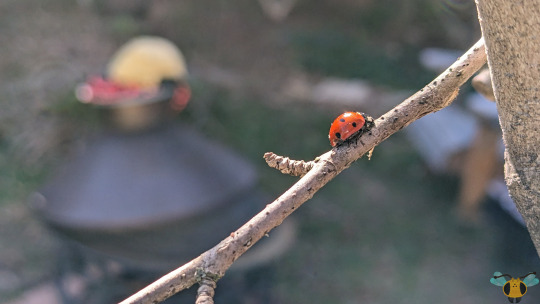

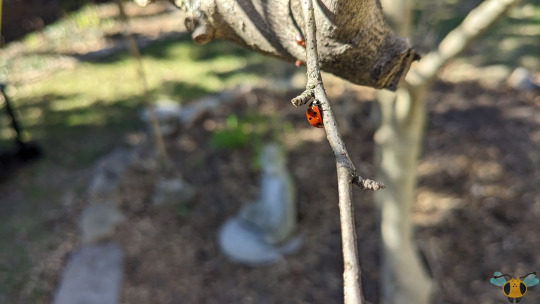


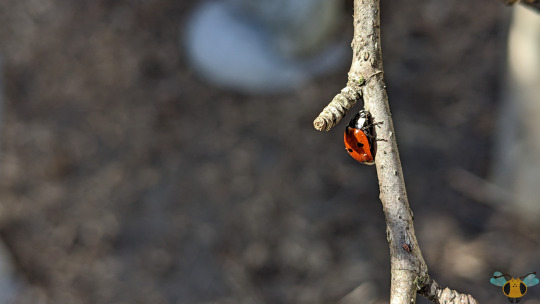
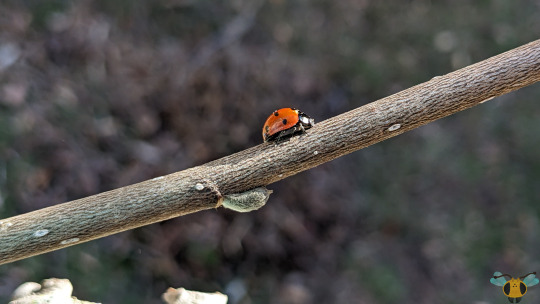

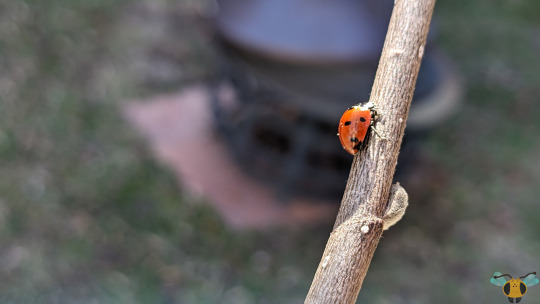
Seven-Spotted Ladybug - Coccinella septempunctata
Spring is starting to take full effect in Toronto. With the warmer weather, the greenery is returning to life, buds are beginning to open and the insects awaken. In particular, I found this small jewel climbing up our white magnolia tree which was on the edge of blooming. Unbeknownst to it, this curious Beetle was actually on a fallen branch that wasn't attached to the tree, but it eventually found its way to more stable ground. No danger of falling of course since Ladybugs are built tough with a strong wingcase and (obviously) they can fly. When a Ladybug is active so early in the spring, it's relying on smaller soft-bodied insects to do the same in order to sustain itself. Moreover, it's also relying on plant-life to be growing in order to sustain those insects. If there's nothing nearby, it fly on to the next area and search The ecosystem can be very complex and this Ladybug is but a small piece of it, but as everything begins to grow again, a Beetle like this can whittle down a few pest insects and ready a summer generation of hungry Aphid-consumers. It's just a small sample of what a new year of insects will bring.
Pictures were taken on April 7, 2024 with a Google Pixel 4.
#jonny’s insect catalogue#ontario insect#beetle#seven spotted ladybug#ladybug#ladybird beetle#coleoptera#insect#toronto#april2024#2024#nature#entomology#invertebrates
13 notes
·
View notes
Photo

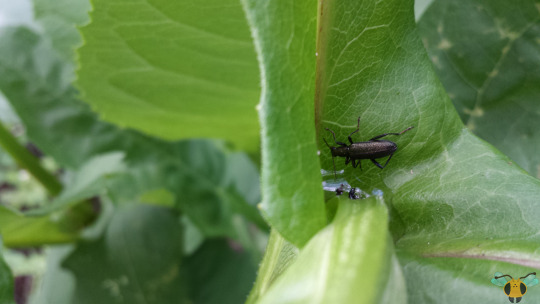

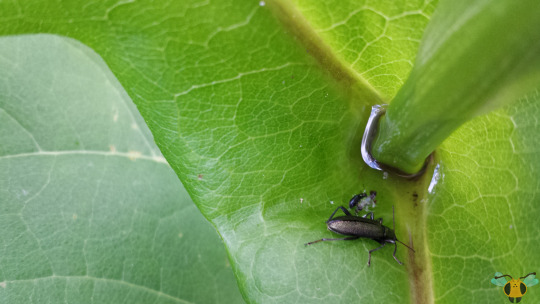
Brassy Long-Joint Darkling Beetle - Arthromacra aenea
We now go from a wide, Bronzed Beetle to a more slender one of Brass. This specie has no common name, so for today’s post its a combination of its subfamily name and the specie name (aenea meaning brassy). The brassy-ness in question refers to the metallic luster of this insect’s shell. This post was scheduled to be uploaded many years ago, but was pulled back at the last minute due to uncertainty on the identification. While unsure on the exact specie for a while, these images have been carefully re-examined. By looking at the shape of this Beetle and comparing this individual to other confirmed sightings on iNaturalist and Bugguide, I can comfortably say that I’m now happy declaring the identification correct...well as much as can be gleaned from pictures. My biggest doubts came from the thorax width and the antennae which appeared to be the wrong type. However, when counting the antennae segments, it became clear that it had been attacked or damaged in some way. The shell has also been impacted and one of its feet is missing, so a confrontation with a predator was likely! Looking at untouched specimens, they have an elongated terminal antennae segment.
Please do not overlook this Beetle’s features if you find a similar Beetle in the wild or in your garden (I kept veering towards Lizard Beetles, Tribe Languriini). If you can, try and get a reasonable picture of the head and eyes. This individual represents a new side of Darkling Beetles (it is a thinner specimen) for the blog, specifically from the Subfamily Lagriinae, better known as the Long-Jointed Beetles (and Arthromacra means “large-jointed”). Like their relatives, they can be primarily found in sources of decaying vegetation and stumps. Even then, water is very important for an insect’s body and to prevent desiccation. A strong, predator-proof, brassy shell needs nutrition to remain intact and healthy. Although somewhat metallic, one would be hard pressed to classify this shell as brassy (the light bouncing of this individual makes it seem like a darkened silver). This isn’t unexpected for this Darkling Beetle whose shell can have a variable coloration between individual. Look for such magnificent colors as dark-orange, brown, grey and even dark green! Having said that, if you find a similar-looking Beetle with a more vibrant green shell, you have likely found one of its relatives: A. pilosella. Red coloration could (I stress, could) mean you’ve found A. robinsoni! Who knew Darkling Beetles could be so metal and so colorful?
Pictures were taken on June 24, 2017 at the Royal Botanical Gardens with a Samsung Galaxy S4. On the subject of bronze and brass, both are alloys composed of copper. Brass is formed of zinc, whereas bronze is bonded with tin.
#jonny’s insect catalogue#ontario insect#brassy long joint darkling beetle#beetle#darkling beetle#coleoptera#insect#royal botanical gardens#june2017#2017#nature#entomology#invertebrates
6 notes
·
View notes
Text
Stonefly - Subfamily: Perlodinae
The Stoneflies of Squamish are still active! My dear friend sent me another find from the highway bridge near the Mamquam River, and this individual is in much better shape compared to the previous one. This is to say the wings are full and the rear cerci are curved and intact. Hopefully this provides a good example of a typical Plecopteran form and gives a lasting impression of how large the wings can appear. Although the wings are airworthy, the pairs apparently do not operate in unison (unlike more common garden insects) and are quite large despite the moderate size of the Stonefly, leading to clumsy flight for the adult. Fortunately, since these insects don't stray too far from their emergence site, flight isn't a big concern for travel. Moreover, it has come to my attention that Stoneflies and similar aquatic insects (e.g. Fishflies and Mayflies) may rely on skimming across water to travel. By placing their abdomens and/or legs on the water's surface, the muscle load on the wings is reduced, the weight carried by the wings is lessened and the wings don't need to beat as much during flight. Observations like this have led to examinations of wing evolution in aquatic insects and theories that ancestors (of these aquatic insects) relied on skimming to supplement flights made with smaller, less developed wings and overall weaker muscles. Don't be fooled, however, this Stonefly can indeed fly.
Video was recorded on April 7, 2024 in Squamish with an iPhone X. For additional information, I recommend the following papers by Marden J. H. et al.: Surface-Skimming Stoneflies (1994) and Surface‐Skimming Stoneflies and Mayflies (2000). The former paper was brought to my attention by the YouTube channel "Ant Lab" after watching an upload that captured slow motion Stonefly, Mayfly and Fishfly take-off and flight (at 3200 FPS). If that sounds interesting, I recommend watching that video as well.
#jonny’s insect catalogue#insect#stonefly#plecoptera#perlodinae#squamish#sḵwx̱wú7mesh#april2024#2024#video#nature#entomology#unidentified#invertebrates
2 notes
·
View notes
Text
European Ground Beetle - Carabus nemoralis
Not only did my dear friend send me pictures of a new specimen for the blog (similar to the Stonefly found earlier), but he also sent video of his interactions with the Bronzed Beetle. In contrast to the Stonefly video, this insect has little inclination to chase a light and instead holds its ground initially. As it does, we can get a good look at the wingcase's beautiful dark-bronze color. Furthermore, towards the beginning of the video, if you look closely at the rear points of the Beetle's thorax, the blue-violet iridescence (absent from the nighttime images) is visible, if only briefly. Combined with my friend's eye-witness of iridescence, that's everything needed to confirm the identification of this Ground Beetle! As shown in this video from careful prodding, this insect's response to trouble to sprint furiously away, and what amazes me most is how the legs work to propel it forward. Slowing the footage down reveals the front legs grip and pull, the middle legs act almost like paddles (through they grip as well), and the back legs push against the ground. Since this Beetle is flightless, sprinting is its only option, but its legs, gait and streamlined form make it a running champion. Moreover, you can imagine moving at that speed is every beneficial for chasing down prey and striking quickly with sharp mandibles! The ground Beetles of Ontario also possess such consistent speed, except for Tiger Beetles which enter ludicrous speed briefly, and then suddenly stop (presumably to "recalibrate", hahaha)!
Video was recorded on April 1, 2024 in Squamish with an iPhone X.
#jonny’s insect catalogue#insect#beetle#european ground beetle#bronze ground beetle#ground beetle#coleoptera#squamish#sḵwx̱wú7mesh#video#april2024#2024#nature#entomology#invertebrates
1 note
·
View note
Text



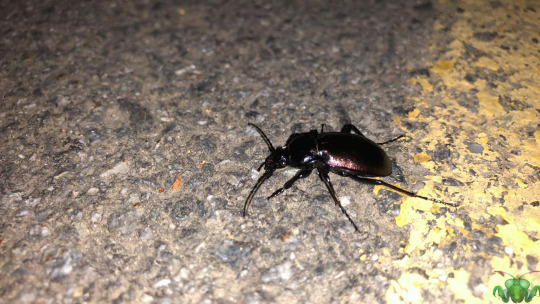
European Ground Beetle - Carabus nemoralis
My dear friend out in Squamish does it again! Another fine insect friend has been found and joins the blog so that it can be explored and observed. He's told me that he's seen many of these individuals recently (the weather in Squamish has been more favorable compared to Toronto) and is curious on what they are. At first glance, I was reminded of the Narrow-Headed Snail Eating Beetle (Sphaeroderus stenostomus) as their body proportions are similar and both appear to have elongated heads and fused elytra (wing-cases) and both individuals are Ground Beetles. This specie, however, is much larger based on the description my friend gave me and also has rear protrusions on the thorax (more on that below). As well, this specie is adventive to North America, having originated from Northern Europe and Iceland apparently. While a new visitor, it isn't consider invasive. Given a Ground Beetle's inclination to hunt, it may even have some benefits to control pest populations and pursue after slower insects. It may not have enlarged mandibles like some distant cousins and reckless speed, but this Carabid can definitely move!
Alongside the name "European Ground Beetle" (which can be a little generic as they are many specie of Ground Beetle across the entirety of Europe), this specie is also known as the Bronze/Bronzed Ground Beetle. These pictures may demonstrate why: note the lustrous shimmer across the abdomen. Particularly in Pictures 1 and 4 where the camera flash has illuminated the Beetle's shell! This is in stark contrast to other Carabids I've observed who tend to have either glossy or matted shells. I'm always happy to see a metallic Ground Beetles as they are relatively rare from my own experience. I'm still hopeful I can find a Fiery Searcher Beetle (Calosoma scrutator) or one of its Caterpillar-hunting relatives to behold their emerald green shell and opaline thoracic highlights. Speaking of the latter, while I appreciate these pictures, the low light conditions hide the thoracic protrusion iridescence which makes this Beetle iconic (and makes identification easier) alongside its bronzed shell. If only nighttime wasn't so productive for these insects; they can hunt from the shadows and conceal themselves far better than during the day.
Pictures were taken on April 1, 2024 in Squamish with an iPhone X.
#jonny’s insect catalogue#insect#beetle#european ground beetle#bronze ground beetle#ground beetle#coleoptera#squamish#sḵwx̱wú7mesh#april2024#2024#nature#entomology#invertebrates
4 notes
·
View notes
Text



Rove Beetle - Dinothenarus sp.
Looking at this flattened insect, it's very difficult to exactly place it down the genus, let alone the specie. With its orange-brown colored legs and its slightly compact body (relative to other insects I've compared it to), my current match is to the Rove Beetles within the genus Dinothenarus. If I had to guess the specie, I'd say D. badipes as the range would fit and there are similarities. The trouble is, there aren't many other observations I can use to narrow it down. I'm likely way off base here without a closer look. If this Beetle had orange-brown coloration across its antennae or the tip of the abdomen I would be far more confident, but it's also likely this individual could be a Platydractus specie or any other similar Rove Beetle within Ontario's range.
Let this be the lesson to all aspiring insect photographers/collectors out there: capture all the details of your finds as best you can. In the case of Rove Beetles, the underside of the abdomen could be examined as well, but please do not agitate insects. In any case if this is a Dinothenarus Beetle, High Park is a great environment to live in! Plenty of insects or decomposing matter to eat (depending on stage/diet), and there are many darkened areas to shelter from the heat of the day or a passing bird. This individual has found a perfect spot to glide underneath thanks to its flattened body. My chasing after it compelled it to take cover beneath a large, fallen branch. Don't forget, however, even with small wing-cases, Rove Beetles can unfold beautiful wings.
Pictures were taken on July 10, 2019 in High Park with a Samsung Galaxy S4. Enjoy the Easter weekend, one and all.
#jonny’s insect catalogue#ontario insect#beetle#rove beetle#dinothenarus rove beetle#dinothenarus#coleoptera#insect#high park#toronto#july2019#2019#nature#entomology#unidentified#invertebrates
3 notes
·
View notes
Text


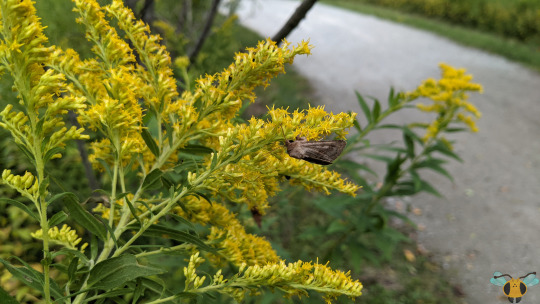
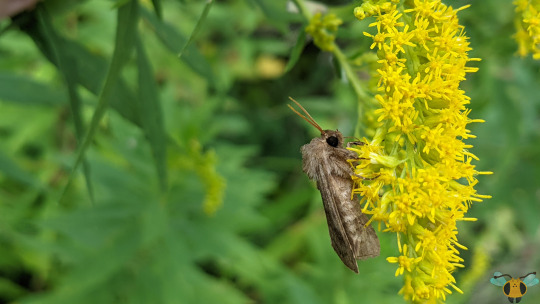



Bronzed Cutworm Moth - Nephelodes minians
I may be completely off base here given the sheer breadth and the number of species within the family Noctuidae (Owlet Moths), but from the images I've examined, this insect is the best match. If anyone has a suggestion for what else this Moth could be, I'll gladly consider them and will investigate (keep the range in mind for this individual which was found in Kleinburg, Ontario). In any case, Cutworms in Caterpillar form have earned a notorious reputation for their feeding which has reinforced their name. They tend to come out at night in search of plant-based food, and most notorious of them chew through plants at the lower stem, cutting them down (hence "Cutworm") to eat the leaves. Feeding behavior like this also subsequently destroys the plant, leaving the roots to pick up the pieces. Aside from toppling plants, other evidence may be left behind from Cutworm efforts including circular-shaped damage and frass. These cuttings can be very intense if multiple Caterpillars occupy the same area (which has also given them the name "armyworm") which can be particularly brutal if swarms find their way into crop production. For this specie, the Bronzed Cutworm can have a potential impact on crops as it has been reported to enjoy corn and cereals, but it seems to be handled through careful monitoring.
The Bronzed Cutworm more frequently seems to be associated with the consumption of grasses. As mentioned above, it will eat the blade from the bottom and slowly spread out until the grass in reach has been clipped. For nighttime detections, be wary for a large Caterpillar that appears as either mottled green or dark brown, with stripes parallel to the "spine" running along the body. It has an orange face with a black covering right behind the head. When threatened, it will likely ball up and shield its head, a key behavior in Cutworms. After having its fill, the adult will eventually emerge from a cocoon and resemble the individual seen in these pictures. That being said, this specie's wings have an incredibly variable appearance with several darker patterns displayed. Some many appear more mottled, some yellow, some pink, and others with a bronze sheen to their wings (but not iridescent). This individual's wings are more lighter/sandier by comparison. When examining the wings, look for a darkened "U-shape" section around a wing-spot. Flower nectar will become its preferred source of food now that mandibles have been swapped for a proboscis. While future damage may be a concern, the wilds here have plenty of grass for all (including very hungry Grasshoppers); the Caterpillars can eat their fill, but must be wary of the hunters that lurk in the grass (see this post for more info).
Pictures were taken on September 11, 2021 in Kleinburg with a Google Pixel 4.
#jonny’s insect catalogue#ontario insect#moth#bronzed cutworm#bronzed cutworm moth#owlet moth#lepidoptera#insect#kleinburg#2021#september2021#nature#entomology#invertebrates
6 notes
·
View notes
Text
Stonefly - Subfamily: Perlodinae
Not only did my dear friend out in Squamish send me pictures of a new order of insect, but he also sent me video of the specimen. This Stonefly was found at a highway bridge near Mamquam River, a great eagle-spotting location during the day if you don't mind the noise of traffic, and it seems a great location to find Stoneflies. Many external observations suggest that concrete bridges and artificial wood structures near flowing water are ideal places to find nocturnal Stoneflies emerging as adults (I tend to find Caddisflies instead). Moreover, they seem to be attracted to lights, and this individual certainly was, so much so it tumbled off the railing! Even after falling, it was very persistent! I'm very fascinated by how the legs become longer and thicker as you go down the body; likely an adaptation from the naiad stage, clinging to rocks. But now, above water, they can fly, but Stoneflies in general aren't strong fliers. This individual would have very great difficulty taking to the air with a broken wing. Hopefully chance smiles upon it to find food and/or mate. The former varies from specie to specie: some Stonefly adults will not eat while others will eat pollen or debris. In all cases, they do have chewing mouthparts, but it's interesting how only some choose to chew. This may be an adaptation centered on emergence time. Perhaps early spring emergent species focus on finding mates rather than focusing on food as pollen-rich flowers may be scarce.
Video was recorded on March 15, 2024 in Squamish with an iPhone X. As well, observe these river beauties carefully. With those long hind cerci and flattened bodies, a sudden glance may mistaken them for Earwigs.
#jonny’s insect catalogue#insect#stonefly#plecoptera#perlodinae#squamish#sḵwx̱wú7mesh#march2024#2024#video#nature#entomology#unidentified#invertebrates
5 notes
·
View notes
Text

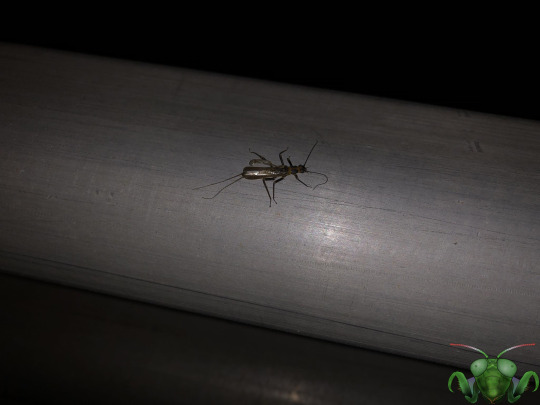
Stonefly - Subfamily: Perlodinae
With special thanks to a dear friend of mine currently in Squamish, another new insect order can now be described on this blog. Joining the insect is the order "Plecoptera". These insects are typically flat-bodied with large membranous wings folded over their back. Many species have cerci protruding from their abdomen and the winged adults are found in close proximity to water. The reason being is primarily two-fold: they spend their time as a predaceous nymph (called a naiad) in water and they are relatively weak fliers (despite their large wings) meaning they won't venture too far from their spot of emergence. At most, they might travel a short distance and search for a mate. Species like this are more commonly known as Stoneflies. With a description like this, they are quite similar to other water-associated insects that gain wings and leave the water as adults such as Alderflies, Mayflies and Caddisflies. However, once you learn the exact shape and construction of their bodies, you'll never mistaken one of these for something else. Even Fishflies are distinguishable given their unbelievable large wings! The common name "Stonefly" apparently arose from a behavior at their armored naiad stage: they cling to large stones as they live underwater and try mightily not to get pulled away by the current as they snatch other animals for food (adults are either herbivorous or do not eat at all).
With water currents in mind, it seems to be a miracle that these insects can even hatch without getting pulled away to oblivion. I think that using a current to aid in dispersal is very clever (assuming the locations are suitable). Moreover, Stonefly eggs have a coating that allows them to stick to passing rocks or other pond debris to give them a (hopefully) suitable place to hatch and feed. When pulled from the rock, they will flail downstream aiming to grab another rock, or else become food for passing fish. With this information in mind, it's no wonder this specie is frequently used as fantastic fish bait. I'm not an angler myself, but if an ample source of larvae can be found clinging to rocks, it might be your lucky day. Myself of course, I'd be content seeing the insects in person and later in a photo. Although great fish bait, we should monitor these insects very carefully. Depending on the specie, the larval lifecycle of this family of insects can range from 6 months to 3 years (during which there could be as many as 30 naiad molts). With such a long development time, we can't be too hasty to take too much. Secondly, like Caddisflies, Stoneflies cannot tolerate water pollution, making them an indicator of environment quality. A biologically based monitor of the water sounds perfect in my opinion.
Pictures were taken on March 15, 2024 in Squamish with an iPhone X. Happy First day of Spring!

#jonny’s insect catalogue#insect#stonefly#plecoptera#perlodinae#squamish#sḵwx̱wú7mesh#march2024#2024#nature#entomology#unidentified#nowruz mobarak#first day of spring#invertebrates
3 notes
·
View notes
Text
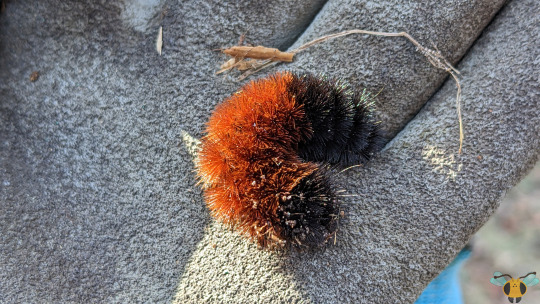

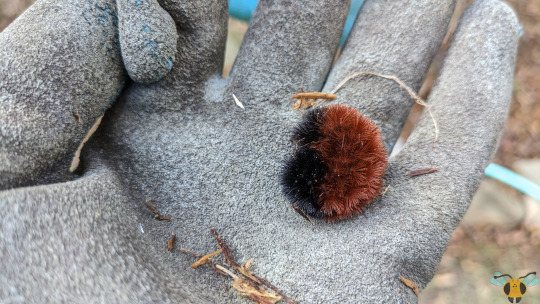
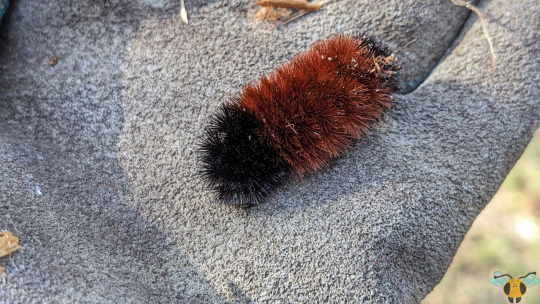
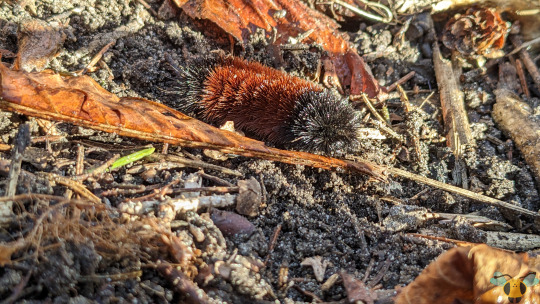


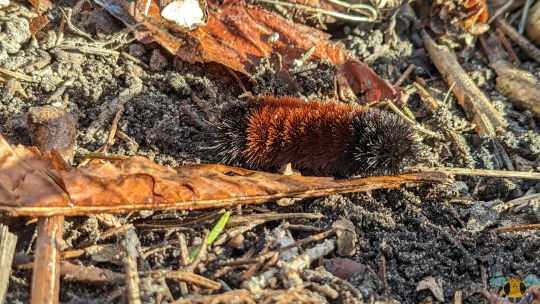


Isabella Tiger Moth Caterpillar - Pyrrharctia isabella
Wednesday was a spectacular day in terms of temperature, almost feeling like summer compared to spring! In my area, flowers have begun to open, the days are getting warmer and sunnier, and spring truly feels like it's here. With that, my family and I took a day to clean up the backyard after a sporadic winter and round up errant leaves and fallen branches from some of the snowfall and winds from winter. It was in this cleanup that my first insect of 2024 was found, that being this fuzzy, ticklish Caterpillar from underneath fallen leaves. I'm always careful to look for hidden residents of the yard like this autumn brood individual. Woolly Bears born in the autumn will eat what they can while plants are plentiful to reach their final instar and then disappear into leaf litter or soil before winter arrives and hibernate until more favorable temperatures. The layers of plants they nestle beneath provide insulation from the worst of cold weather and snow.
When warm weather returns, these wrigglers thaw out and will become Moths with the arrival of spring. With Wednesday's warmth, this fluffy individual was likely active but got caught up as the leaves were shoveled, and took on its balled-up posture to protect its vulnerable underbelly. If you find a specimen like this one, all it takes is a bit of sunshine and a lack of agitation for the ball to unfurl and begin exploring you. After taking pictures (see Picture 10), I placed this Caterpillar back in a sunny garden spot and concealed it with fallen leaves. Currently, the tools for success for this individual would be a quick meal from any healthy vegetation (if needed) and then a safe area to form a cocoon around itself from debris and grasses. With 2 weeks to 1 month, a dazzling orange Moth will emerge, and hopefully that's a great indication that Toronto has officially entered spring without any caveats.
Pictures were taken on March 13, 2024 with a Google Pixel 4. This post is also counted as a milestone as I've received the notification that the blog's posts have received over 500 reblogs. To everyone who enjoys these insects and shares them with others, I offer my sincerest thanks. I couldn't do this without you.
#jonny’s insect catalogue#ontario insect#caterpillar#isabella tiger moth#woolly bear caterpillar#isabella tiger moth caterpillar#moth#insect#lepidoptera#toronto#march2024#2024#nature#entomology#milestone#500 reblogs#500reblogs#invertebrates
7 notes
·
View notes
Text
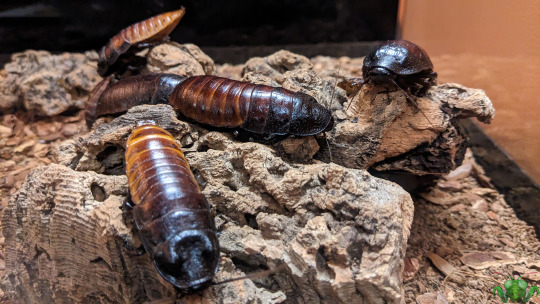
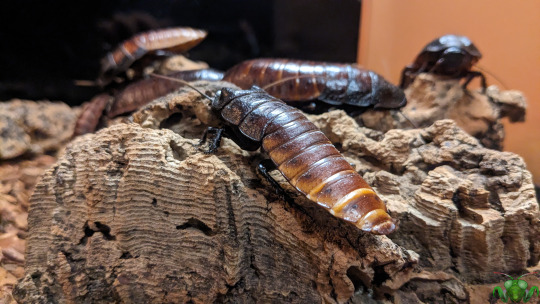
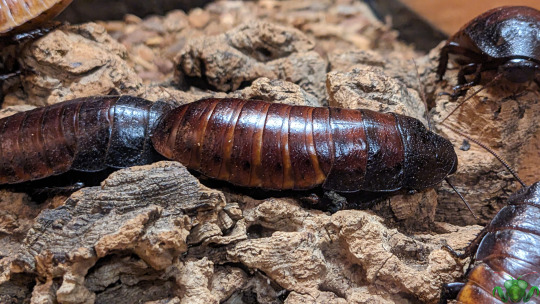


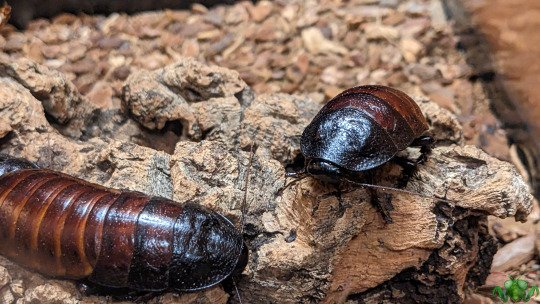
Madagascar Hissing Cockroach - Gromphadorhina portentosa
With this set of insect images, all pictures from the ROM for the year 2023 are proudly displayed on this blog for you to enjoy. I've already gone at length discussing these feisty beans and their habits, behaviors and routines. While many onlookers may not see these armored insects as appealing, I take great knowing the role that they have within their own ecosystems and the opportunities they provide for eager minds to learn, whether as pets or in exhibits. It could be worse if you're not a Roach fan: as this specie lacks wings, it can't suddenly startle you by becoming airborne and (unintentionally) buzzing towards you. They can run rather quickly, however! Having visited this exhibit many times before, it would be a benefit to have additional information displayed regarding these curious insects.
Though simple, there's so much to learn about them, and many myths that can be dispelled so as to not treat all Roaches as "dirty insects" (admittedly these species does consume debris and rotting material as they are decomposers by nature). An interactive series of hissing samples would provide a lot of insight into how they interact and communicate with each other and the other creatures they encounter. Perhaps hearing it live is more authentic, but in a carefully curated environment such as this one, agitating the exhibit denizens for spectacle wouldn't be the best idea. Besides, a sudden hiss from such a small creature is quite startling the first time, especially if you're not expected it. It's up to the Cockroach to determine how aggressively it will press air from its spiracles.
Pictures were taken on December 19, 2023 with a Google Pixel 4. Please go and visit the bugs.
#jonny’s insect catalogue#ontario insect#roach#madagascar hissing cockroach#cockroach#blattodea#insect#ROM insect#royal ontario museum#insect exhibit#toronto#december2023#2023#nature#entomology#invertebrates
24 notes
·
View notes
Text
Insect Songs: Dog-Day Cicada - Neotibicen canicularis & Black-Legged Meadow Katydid - Orchelimum nigripes
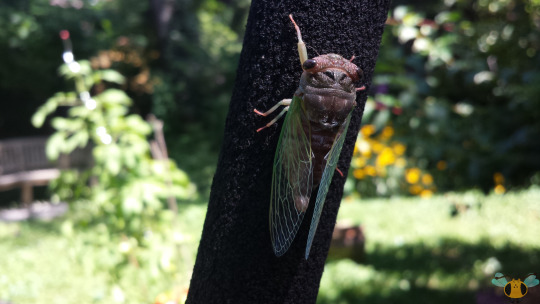
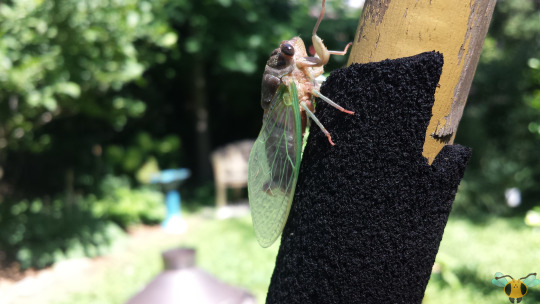

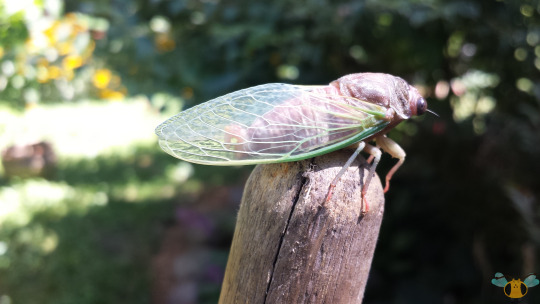
In today's exploration of insects and their songs, we 2 familiar species today that are quite prevalent in Ontario's summer months. We begin with the tree-dwelling shriekers that seem to grow even louder when heat increases. Just as with Crickets and other Orthopterans, the large-bodied Cicadas only sing if they are male. To produce their sound, they rapidly expand and contract a membrane behind their thorax called a tymbal. Knowing this information, you can actually identify males and female by looking for the tymbals, which (in this specie) is located underneath the wing. Be very gentle when handling a Cicada in order to see this tymbal, and if it screeches in response, it's definitely a male. That said, unlike Orthopterous insects, Cicadas do not use stridulation to produce their song, as that process describes insects rub certain body parts together (e.g. see below) to produce sound. Vibrating a membrane doesn't match the description. If anything, it's more like flexing a muscle and allowing the hollow-filled body to amplify the sound so that all can hear it.
Pictured below is a typical example of how a Cicada song normally appears in audio form. It is a distinct, clear sound. Headphone warning, a Cicada shriek can be very shrill, even if the audio has been gently reduced.

As mentioned in this blog's 100th post, the Cicada's song appears continuous because of the tremendously rapid expansion and contraction of this membrane. The muscles controlling the membrane are so powerful that the tymbal can vibrate several hundred times per second. The faster the vibration builds (for this specie), the higher the pitch of the song becomes. That said, just as a Cricket's chirp can be isolated to clicks, a Cicada's song can be slowed down to hear the individual pulses. After slowing the screeching down by several hundred times, this is the result:
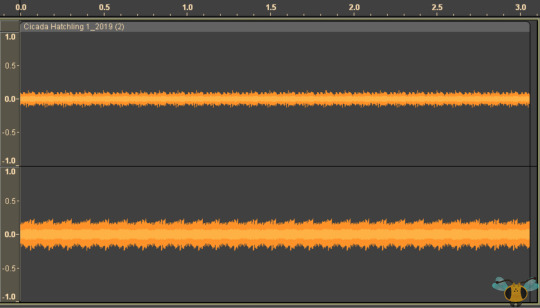
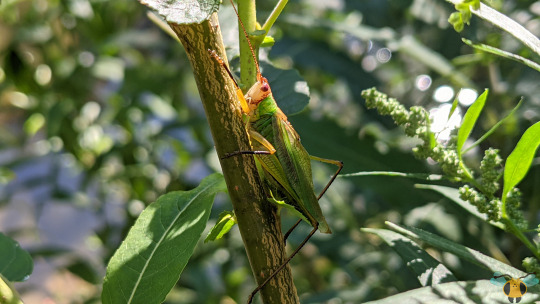

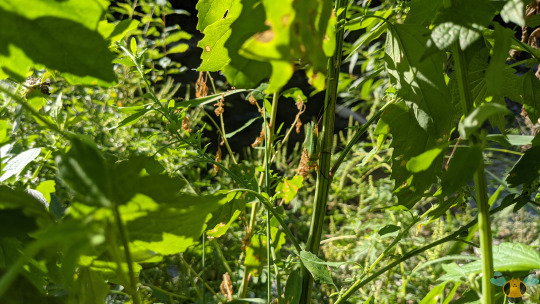
On the other side of the summer of insects, most Katydids generate their mating calls using wing-to-wing stridulation. There are exceptions of course (such as the Drumming Katydid), but today's specie has a loud method of communication! Like its Cricket friends, the loud, continuous sound is many clicks in rapid-succession. In fact, you can actually hear the beginnings of the clicks at the start of the song before the wings suddenly accelerate and make the call distinctive. Considered the role flight muscles play in controlling the wings and their noises, it's no surprise how the song can suddenly turn loud. It's very likely that the song can only be sustained in short bursts to prevent muscle damage or heat buildup, which is to say nothing of exposing oneself to a predator. The sound is alluring, for both mate and hunter alike. Pictured below is a typical example of the Black-Legged Meadow Katydid's song (headphone warning):
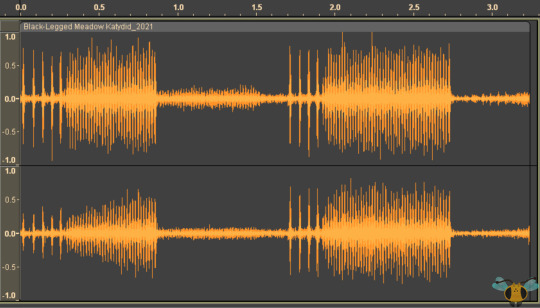
Do note, that while this is louder compared to the Cicada song, I was much closer to the source. If I was next to a singing Cicada, that too would have been an incredible amount of decibels! Nevertheless, when this Katydid's song is slowed down, the individual clicks become more prominent. Looking at it immediately after slowing the tempo down a few hundred times, a quick burst of less that one second becomes nearly 45 seconds of clicks! To showcase this, I've included a "portal" that offers a zoomed in look at the slowed song. Each spike in amplitude is a click of the wing-scraping. Even at reduce speed, you can hear the gradual acceleration of the clicking as the song goes on (headphone warning):

Pictures were taken on August 24, 2019 (Dog-Day Cicada) with a Samsung Galaxy S4 and on September 5, 2021 (Meadow Katydid) with a Google Pixel 4. Audio amplitude graphs were created using Audacity and samples from the following blog videos:
Black Legged Meadow Katydid | Dog-day Cicada
#jonny’s insect catalogue#ontario insect#cicada#dog day cicada#katydid#bush cricket#black legged meadow katydid#orthoptera#hemiptera#auchenorrhyncha#true bug#insect#insect audio#toronto#august2019#2019#september2021#2021#insect clicking#insect noise#a closer look#insect chirping#nature#entomology#invertebrates
5 notes
·
View notes
Text
Insect Songs: Fall Field Cricket - Gryllus pennsylvanicus

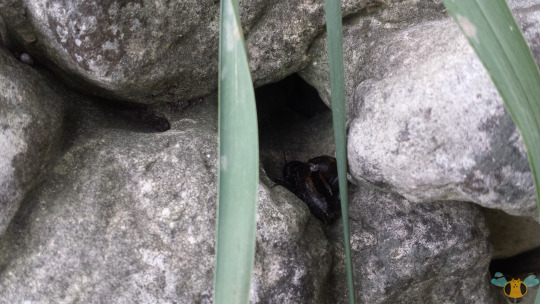
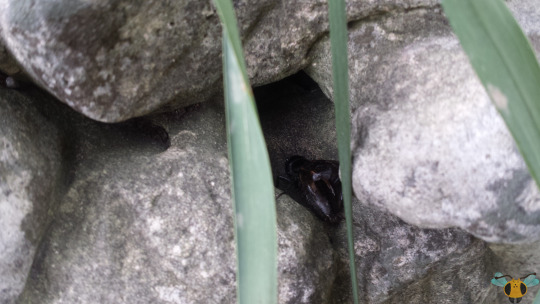
Throughout last week I revisited a video on this blog that showcases a crafty Cricket sheltering within a rocky hollow while singing his song. His hideaway simultaneously functioned as both protection from intruders and amplifier of his chirping. While both listening to the audio over and over to clean it up and writing a description for its upload onto YouTube, I was reminded of one of the more important facts regarding insect noises and calls of this type. Plain and simple, what we're hearing is not one continuous sound; it is instead a series of rapid clicks/blips that coalesce together into a series of chirps. It sounds continuous given the speed at which the (in this case) wings scrape against each other. For this post, I want to show you what I mean and allow the opportunity to hear the difference, but I do apologize for any background noise. The audio displayed here is a small sampling taken directly from the singing Cricket video residing on this blog. I recommend you revisit it to see this great specimen in action and observe how his chirps are made using his wings rather than his legs.
Pictured below is a typical example of how a Field Cricket song normally appears in audio form. Each chirp appears in a series of 3 amplitude spikes. Listen for yourself:
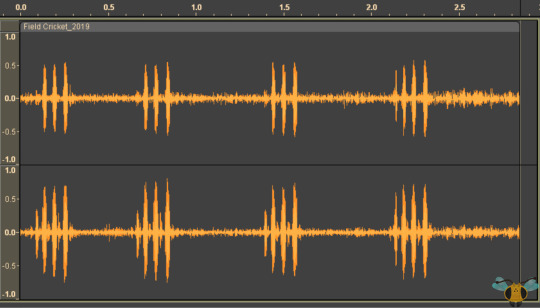
Sounds normal and as to be expected. The rapid wing movement makes a cohesive, pleasant, attention-grabbing chirp. However, if you isolate one of those amplitude spikes in the series and slow down the tempo by (at least) 100%, you can start to hear the individual clicks made by the wing stridulation. The sample below has been slowed by 200% in order to make the clicks a bit more distinguishable. And so, here are the individual clicks in a Cricket's song:

Admittedly, the background noise make it sound like there is a loading delay between clicks. Rest assured, this is not the case: the audio sounds correct. There you have it: the artistry of a male Field Cricket's song. For the next post, we will turn our attention to 2 more insects that grace us with songs during the summer months. Stay tuned for more.
Pictures were taken on October 7, 2019 with a Samsung Galaxy S4. Audio amplitude graphs were created using Audacity and samples from the following blog video: Fall Field Cricket
#jonny’s insect catalogue#ontario insect#cricket#insect songs#insect chirping#insect clicking#insect audio#field cricket#fall field cricket#orthoptera#insect#toronto#audio#2019#2021#october2019#nature#entomology#a closer look#insect noise#invertebrates
1 note
·
View note
Text



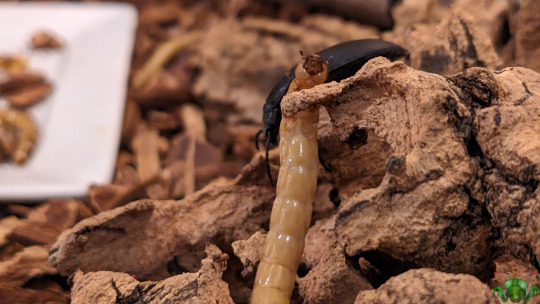


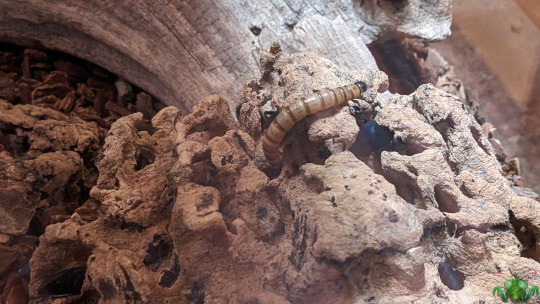
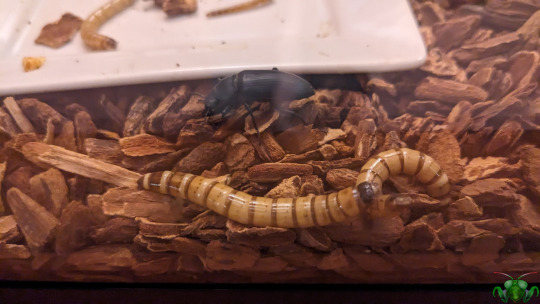
Zophobas Darkling Beetle (Superworm) - Zophobas morio
There's just something about today that warrants the showcase of "worms" and this particular specie of Darkling Beetle. Of course, the "worms" here aren't actual worms (referring to Annelids), there are the larval form of the armored individuals. This specie has already been covered before in detail; these pictures are actually part of the same set from a previous December post, so the information provided there also applies here. Although larvae and adults live together in the same terrarium, the latter will not eat the former. At least not while food is plentiful and there are no carcasses from expired Superworms to consider. Larvae however, are much more likely to eat each other, especially if some molt into defenseless pupae. Under the circumstances here, they aren't likely to molt while food and water are plentiful and many larvae are clustered together. Only when isolated from each other or placed in a secure environment will a larva turn into a pupa.
There are none here, but the Z. morio pupa are brownish-white, shrimp-shaped pupa and they eventually metamorphose into the adult Beetles you see before you. It's a staggering change, but the insect world is full of many astounding transformations as larvae/nymphs grow large, mature, and sprout wings. While the adult Beetles is heavily armored and can move around with greater locomotion, security and grip, they do lose certain advantages from their time as larvae. They can easily wriggle and navigate through the earth (or wood chips here), fit into small tunnels without needing to chew and expand them, and contour themselves along a surface as sleek-formed grubs. While these advantages may be missed, what is gained in adulthood (including the abilities to fly and reproduce) is more than worth it. If they would be told what was in store for them by an insect "Herald of the Change", would they accept?
Pictures were taken on December 19, 2023 with a Google Pixel 4. Check out the many insects of the Royal Ontario Museum if you happen to be in town.
#jonny’s insect catalogue#ontario insect#beetle#beetle grub#zophobas darkling beetle#zophobas darkling beetle larva#superworm#darkling beetle#coleoptera#ROM insect#royal ontario museum#insect#toronto#december2023#2023#nature#entomology#insect showcase#bug box#insect exhibit#dune part two#dune part 2#dune 2#atreides#invertebrates
8 notes
·
View notes
Text
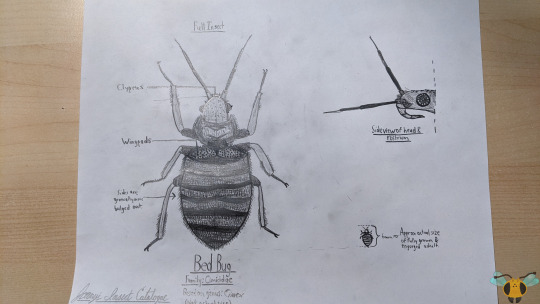
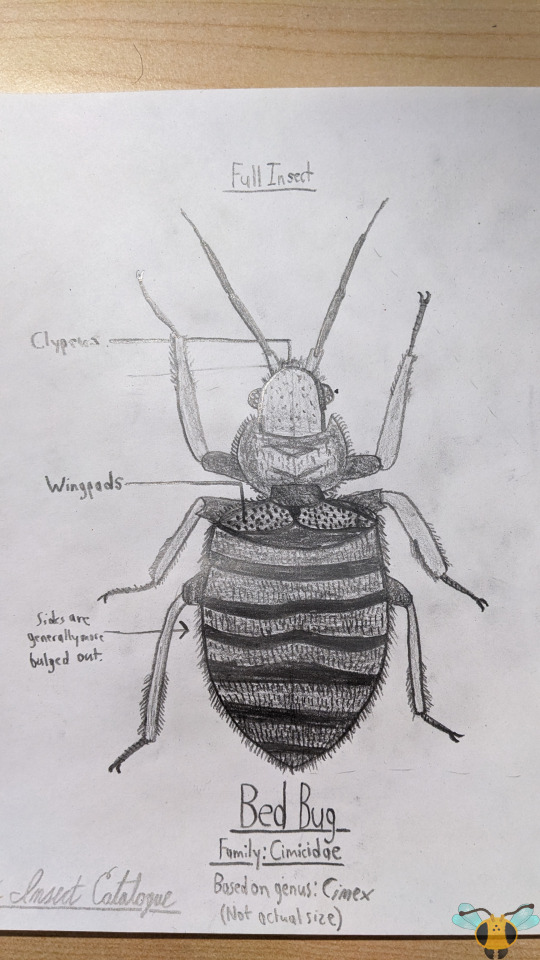


Bed Bug Diagram - Family: Cimicidae | Based on Cimex spp.
I don't plan on encountering this insect live during my lifetime (can't rule it out, however), but they are still important insects to acknowledge, prepare for and learn about. Furthermore, in a panic other insects can be misidentified as this one. As such, I've drawn a diagram of a traditional Bed Bug form (primarily based on the Cimex genus; they are commonly associated with humans) for the purposes of insect identification and to highlight some key Bed Bug information. To make this diagram, I examined macrophotography and pinned specimens to give this insect as detailed a glow-up as possible. In the real world, they are tiny Bugs around the size of pepper grains while nymphs and they average 6mm in length after the adult molt (size varies across species). With horizontally flattened bodies, they can tuck into safe locations and hide until a warm-blooded animal settles near them, signaling them with body heat. With that curved rostrum, you would be right to think that they are biters and bloodsuckers! They need nutrient-rich sustenance in order to provide for their eggs. As they feed, their abdominal carapace gradually goes from flattened to engorged! How fortunate that their wing pads are not functional, drastically limiting their dispersal and pursuit of hosts (but in fairness, it's better to let the host burn its own energy by moving).
While Bed Bugs may leave their host after they feed, they will apparently remain close by to visit the host again if more blood is needed. Since female Bed Bugs (depending on the species) can lay several eggs a day over their lifetime with blood meals, a handful of Bed Bugs can rapidly create large infestations in a nest, den or mattress. Humans bitten by Bed Bugs tend to discover itchy red spots where the skin has been pierced, but they aren't the only mammalian host. Bed Bugs are reported to select a preferred host such as a rodent, lagomorph, bat or bird and stick with them. Problems arise, however, when a better host presents itself and the Bug can transfer to that host, reaping benefits such as a communal host environment, lack of acclimated defenses and/or access to more nutritious blood. With that considered, it's remarkable that only 2 species of Bed Bug are consistently associated with human hosts (that being C. lectularius and C. hemipterus). With their feeding habits, small size and propensity for infestation, it's no wonder why Bed Bug sightings elicit fear, action and discomfort. Confirmed sighting should be handled swiftly! However, always keep in mind that they are small, and in the heat of the moment other insects may be misidentified as Bed Bugs. For me, I've had many a text message over a supposed Bed Bug, only for it to be a Carpet Beetle or its larvae, a slightly "more pleasant" insect to find in the home.
Diagram drawn with pencil and paper February 22-24, 2024 with detailing and touch-ups made on the 26th.

#jonny’s insect catalogue#ontario insect#bed bug#bedbug#insect diagram#art#insect art#true bug#hemiptera#heteroptera#insect#february2024#2024#toronto#nature#entomology#insect schematic#not to scale#invertebrates
7 notes
·
View notes